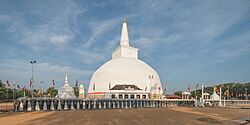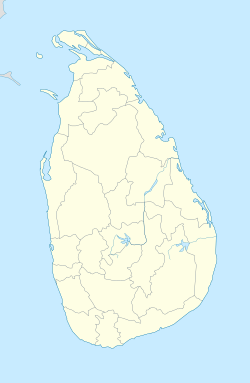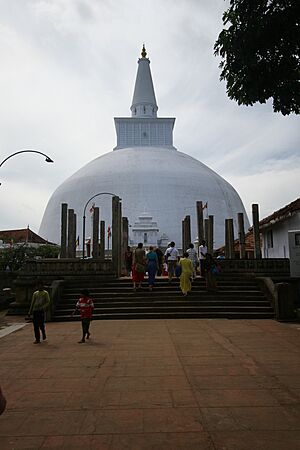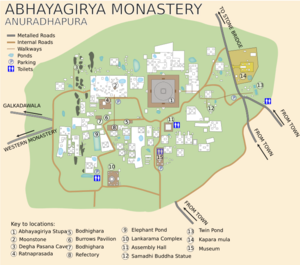Anuradhapura facts for kids
Quick facts for kids
Anuradhapura
අනුරාධපුර
அனுராதபுரம் |
|
|---|---|

Ruwanwelisaya
|
|
| Country | Sri Lanka |
| Province | North Central Province |
| District | Anuradhapura |
| Established | 5th century BC |
| Government | |
| • Type | Municipal Council |
| Area | |
| • City | 7,179 km2 (2,772 sq mi) |
| • Urban | 36 km2 (14 sq mi) |
| Elevation | 81 m (266 ft) |
| Population
(2012)
|
|
| • City | 50,595 |
| • Density | 2,314/km2 (5,990/sq mi) |
| Demonym(s) | Anuradhians |
| Time zone | UTC+5:30 (Sri Lanka Standard Time Zone) |
| Postal code |
50000
|
| UNESCO World Heritage Site | |
| Official name | Sacred City of Anuradhapura |
| Criteria | Cultural: ii, iii, vi |
| Inscription | 1982 (6th Session) |
Anuradhapura is a major city in the north central part of Sri Lanka. It is the capital of the North Central Province and the Anuradhapura District. The city is about 205 kilometers (127 miles) north of Colombo, the current capital. It sits by the historic Malwathu Oya river.
Today, Anuradhapura is a World Heritage Site. It is famous for its well-preserved ancient ruins. These ruins show the history of the ancient Sinhalese civilization.
Historians believe the city was founded around 437 BCE. However, people have lived here for much longer. It has been a major settlement for almost 3,000 years. This makes it one of the oldest continuously occupied cities in Asia.
Anuradhapura was very important for the ancient Sinhalese civilization. It was known for its amazing water systems (hydraulic engineering). It was also a key center for Theravada Buddhism. For 1,500 years, it was the longest-serving ancient capital of Sri Lanka.
It was the first capital of the Sinhala Kingdom of Rajarata. It became a major Buddhist pilgrimage site. Many ancient Buddhist temples are found here. These include the famous Anuradhapura Maha Viharaya and the Jaya Sri Maha Bodhi. The Jaya Sri Maha Bodhi is the oldest living, documented tree planted by humans. It is believed to be a branch from the sacred fig tree in Bodh Gaya, India. This is where the Buddha found enlightenment. Today, these ancient temples and monasteries cover a large area of the city.
The city was mostly destroyed around 993 CE. This happened during an invasion from South India by the Chola kingdom. Even though some kings tried to bring the capital back, Anuradhapura did not become a major city again until the 1800s. However, it remained a very important place for Buddhist pilgrims. It is still a spiritual destination today. The modern city began to grow in the 1870s. Much of the current city was moved in the mid-1900s. This was done to protect the ancient capital site. Today, Anuradhapura is a key road and railway hub in northern Sri Lanka. It is also the headquarters for Sri Lanka's archaeological work. Tourism is a big part of its economy.
Contents
What's in a Name? The Story of Anuradhapura
According to old records like the Mahāvaṃsa, the name Anuradhapura comes from a minister named 'Anuradha'. He served Prince Vijaya, the first Sinhalese king (543–505 BCE). Legend says Anuradha started the settlement that later became this city. However, discoveries show people lived here even earlier, around 1000 BCE.
The name 'Anuradhapura' means 'city of Anuradha'. In languages like Sinhala, Sanskrit, Pali, and Tamil, "pura" means 'city'. Before it was a city, it was called 'Anuradhagrama'. This meant 'village of Anuradha', where "grama" means 'village'.
Ancient Greek and Roman scholars, like Strabo and Claudius Ptolemy, mentioned this older name. Ptolemy's map from the 2nd century CE called the place 'Anourogrammoi'. It is thought that when King Pandukabhaya (474–367 BCE) expanded the village into a city in 437 BCE, its name changed to Anuradhapura.
Here are the key steps in how the name developed:
- The first small settlement was named Anuradhagrama after minister Anuradha (6th century BCE).
- Anuradhagrama means 'village of Anuradha'.
- The name changed to Anuradhapura when the settlement grew into a city under King Pandukabhaya (437 BCE).
- Anuradhapura means 'city of Anuradha'.
How Anuradhapura Grew: Early History
Anuradhapura shows us how early cities in Sri Lanka began. Its development is linked to the spread of iron technology around 1000 BCE. This led to the rise of many ancient civilizations. The city's history goes from its founding in the 4th century BCE to its abandonment around the end of the 10th century CE. It was briefly reoccupied in the 11th century. Some major monuments were also restored in the late 1200s.
The Iron Age in Anuradhapura
Even though old stories say the city started in the 5th century BCE, archaeological digs show people lived here as early as the 10th century BCE. During this 'protohistoric Iron Age' (900-600 BCE), people started using iron tools. They also used pottery, had horses and cattle, and grew rice.
By 700-600 BCE, the settlement in Anuradhapura covered at least 50 hectares (123 acres). The land around the city was fertile and easy to water. It was also in a good spot, near major ports. Thick jungles around the city helped protect it from invaders.
Digs at Anuradhapura have found special pottery called Painted Gray Ware. This pottery comes from the early historic period (600-500 BCE). It shows connections with North India from the Vedic period.
The Early Historic Period
Details about the city's growth from 500 to 250 BCE can be found in old Sinhalese records. These records say that King Pandukabhaya carefully planned the city. He added gates and areas for traders. At that time, the city covered one square kilometer (0.38 square miles). This made it one of the largest cities in Asia.
The city was mostly left empty after invasions by the Chola kings from South India. This happened with Rajaraja I in 993 CE and his son Rajendra I in 1014 CE. According to the Culavamsa (an old chronicle), Anuradhapura was "utterly destroyed" by the Chola army. However, people continued to live there, as visitors like Robert Knox noted. So, Anuradhapura was the capital of Sri Lanka for about 1,500 years, from 437 BCE until 1017 CE.
Buddhism's Influence
Anuradhapura was a very important place for early Theravada Buddhism. Famous Buddhist thinkers, like Buddhaghosa, lived here.
During the rule of King Dhatusena (455-473 CE), Buddhist texts were reviewed and edited. Also, 18 new temple complexes (called vihara) were built. A statue was also put up for Mahinda. He was the Indian prince-monk who brought Buddhism to Sri Lanka.
Later in the Anuradhapura period, the royal family and nobles strongly supported Buddhism. They often ordered artworks and gave them to Buddhist temples. In return, the temples and local Buddhist communities supported the king's rule. Artworks showing Avalokiteśvara, the Bodhisattva of Mercy and Compassion, became very popular.
Anuradhapura Today: The Modern Era
Rediscovering the Ancient City
For many centuries, only a few people lived in the area. But local people always knew about the ancient ruins. In 1681, Robert Knox wrote about it in his book, An Historical Relation of the Island Ceylon. He said that a watch was kept at "Anurodgburro," and beyond it, people did not obey the King of Kandy. In 1821, John Davy wrote that Anuradhapura was a "small mean village" with a "large tank, numerous stone pillars, two or three immense tumuli." He noted it was still a sacred place for pilgrims.
Digging Up the Past
Archaeological digs have happened at the site since 1884–86. These were started by Stephen Montagu Burrows.
The Sacred City and the New Town
Anuradhapura became the main administrative center for the North Central Province. When the Northern Railway line was built, Anuradhapura became an important railway town. The Anuradhapura railway station opened in 1904.
In 1949, the government asked Oliver Weerasinghe to create a plan to preserve Anuradhapura. This plan aimed to build a new planned town east of the old one. This created the Sacred City of Anuradhapura, protecting the ancient site. Many government offices and courts moved to the "New Town." The Anuradhapura Preservation Board was set up for this purpose.
Nissanka Wijeyeratne was the Government Agent (a top government official) for Anuradhapura District from 1958 to 1962. He was very well-known. His importance made sure that Anuradhapura's needs were heard by the highest officials in Colombo. He was also the Chairman of the Anuradhapura Preservation Board.
This was a time of big changes for Anuradhapura. The new town was being built, and people from the old town were moving. He managed this change with great skill. While in Anuradhapura, he honored H. R. Freeman, a popular British Government Agent. Wijeyeratne was good at seeing the big picture and focusing on key issues. He also set up the Sacred City of Anuradhapura and moved the urban city to the new town. He was also responsible for creating the Anuradhapura Airport.
Important Holy Places
- Jaya Sri Maha Bodhi
- Ruwanwelisaya
- Thuparamaya
- Lovamahapaya
- Abhayagiri Dagaba
- Jetavanarama
- Mirisaveti Stupa
- Lankarama
Other Ancient Structures
- Dakkhina Stupa
- Isurumuniya
- Kiribath Vehera
- Kuttam Pokuna
- Mahamevnāwa Gardens
- Naka Vihara
- Ranmasu Uyana
- Rathna Prasadaya
- Samadhi Statue
- Sela Cetiya
- Toluvila statue
- Vessagiriya
Who Lives in Anuradhapura?
Anuradhapura is home to people from different backgrounds. Most residents are Sinhalese. There are also groups like Sri Lankan Moors and Sri Lankan Tamils.
| Ethnicity | Population | % Of Total |
|---|---|---|
| Sinhalese | 51,775 | 91.42 |
| Sri Lankan Moors | 3,825 | 6.75 |
| Sri Lankan Tamils | 850 | 1.50 |
| Indian Tamils | 45 | 0.08 |
| Other (including Burgher, Malay) | 137 | 0.24 |
| Total | 56,632 | 100 |
Source: www.statistics.gov.lk - Census 2001
Weather in Anuradhapura
Anuradhapura has a tropical savanna climate. This means it is generally hot all year with a wet season and a dry season.
| Climate data for Anuradhapura (1991–2020) | |||||||||||||
|---|---|---|---|---|---|---|---|---|---|---|---|---|---|
| Month | Jan | Feb | Mar | Apr | May | Jun | Jul | Aug | Sep | Oct | Nov | Dec | Year |
| Record high °C (°F) | 35.0 (95.0) |
37.4 (99.3) |
39.2 (102.6) |
38.9 (102.0) |
38.3 (100.9) |
36.8 (98.2) |
38.1 (100.6) |
38.3 (100.9) |
38.5 (101.3) |
37.3 (99.1) |
35.4 (95.7) |
33.7 (92.7) |
39.2 (102.6) |
| Mean daily maximum °C (°F) | 30.4 (86.7) |
32.2 (90.0) |
34.8 (94.6) |
34.7 (94.5) |
33.7 (92.7) |
33.2 (91.8) |
33.5 (92.3) |
33.8 (92.8) |
33.9 (93.0) |
32.5 (90.5) |
30.8 (87.4) |
29.8 (85.6) |
32.8 (91.0) |
| Daily mean °C (°F) | 26.2 (79.2) |
27.2 (81.0) |
29.1 (84.4) |
29.6 (85.3) |
29.5 (85.1) |
29.3 (84.7) |
29.4 (84.9) |
29.4 (84.9) |
29.3 (84.7) |
28.5 (83.3) |
27.1 (80.8) |
26.2 (79.2) |
28.4 (83.1) |
| Mean daily minimum °C (°F) | 21.8 (71.2) |
22.2 (72.0) |
23.5 (74.3) |
24.6 (76.3) |
25.4 (77.7) |
25.4 (77.7) |
25.2 (77.4) |
25.0 (77.0) |
24.7 (76.5) |
24.0 (75.2) |
23.3 (73.9) |
22.6 (72.7) |
24.0 (75.2) |
| Record low °C (°F) | 17.5 (63.5) |
16.6 (61.9) |
17.6 (63.7) |
21.2 (70.2) |
20.5 (68.9) |
21.8 (71.2) |
22.8 (73.0) |
22.3 (72.1) |
21.7 (71.1) |
20.3 (68.5) |
18.4 (65.1) |
16.9 (62.4) |
16.6 (61.9) |
| Average precipitation mm (inches) | 86.0 (3.39) |
60.1 (2.37) |
62.1 (2.44) |
180.1 (7.09) |
93.8 (3.69) |
15.4 (0.61) |
23.6 (0.93) |
42.6 (1.68) |
66.5 (2.62) |
259.0 (10.20) |
281.4 (11.08) |
224.6 (8.84) |
1,395.2 (54.93) |
| Average precipitation days (≥ 1.0 mm) | 6.4 | 4.3 | 5.0 | 11.0 | 5.9 | 2.5 | 2.5 | 4.4 | 5.1 | 13.8 | 17.2 | 12.2 | 90.4 |
| Source: NOAA | |||||||||||||
Getting Around Anuradhapura
Anuradhapura is well-connected by both trains and roads.
The Northern railway line links Anuradhapura to Colombo, Jaffna, and Kankesanthurai. The Anuradhapura railway station is the city's main train stop. Important trains like the Yal Devi and Uttara Devi stop here.
Many bus routes pass through Anuradhapura. These connect Colombo to the northern province. Some common routes are 04, 15, 57, and 87.
Anuradhapura is a central city in Sri Lanka. Roads directly connect it to many other major cities and towns. You can reach places like Vavuniya, Dambulla, Matale, Puttalam, Trincomalee, Jaffna, Kurunegala, and Kandy by road.
See Also
- Bassawakkulama reservoir
- Ranmasu Uyana
- Tissa Wewa reservoir





